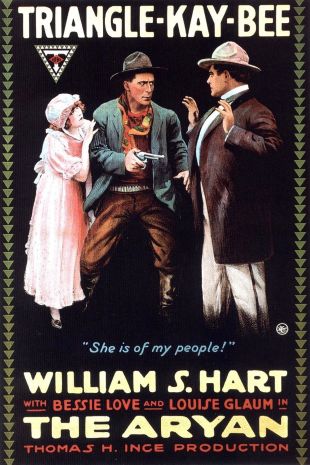The man who virtually invented the Hollywood studio system, producer Thomas Ince was a member of an acting family. His brothers Ralph and John Ince would continue performing into the talking picture era, but Thomas grew disenchanted with the long, lean days between theatre jobs. In 1910 he entered films as an actor at Biograph studios in New York, then joined Carl Laemmle's Independent Motion Pictures Company as a director, keeping one step ahed of the Motion Pictures Patent Company who wanted to put the renegade Laemmle out of business. While he tackled all sorts of subjects, Ince was most strongly drawn to westerns. He wanted to achieve the sort of spectacular effects accomplished with minimal facilities that his former employer D.W. Griffith had done, but the I.M.P. company was plagued with bad management and disorganization. Almost instinctively, Ince hit upon the formula of carefully pre-planning his films on paper (something Griffith never did), then meticulously breaking down the shooting schedule so that several scenes could be shot simultaneously by assistant directors. This was the dawning of the assembly-line system that all studios would eventually adopt; to better facilitate his theories of filmmaking, Ince purchased 20,000 acreas of seacoast land, upon which he built a studio named Inceville. While he directed most of his early productions, Ince eventually had to give up this responsibility to such proteges as Francis Ford, Jack Conway and Frank Borzage. Signing stage star William S. Hart in 1914, Ince managed to find a man who could both act and direct -- on the same relatively meager salary. The Ince product of the mid teens was impressive, though when seen as a whole one finds a tiresome reliance upon tragic endings -- which were hailed as "realism" at the time but which now seem contrived. Ince became a partner with D.W. Griffith and Mack Sennett in the new Triangle Company in 1915. Following the lead of Griffith's Birth of a Nation (1915), Ince turned out a slightly ludicrous but undeniably spectacular anti-war film, Civilization, in 1916; it should have been his chef d'oeuvre, but a shift in America's war policies caused Civilization to end up in the red. In 1918, Ince set up a brand new studio in Culver City, California; its administration building, designed in the form of an antebellum Southern mansion, has weathered eight decades, being taken over by David O. Selznick in the '30s, by Desilu in the '50s, and most recently by Grant Tinker/Gannett Productions. Though Ince had virtually given up directing by 1918, he continued taking directorial credit for his prestige productions; a notoriously vain man, Ince enjoyed seeing his name on screen, and even had his signature imprinted upon his films' protection leader. In 1919, Ince formed Associated Producers Inc. with several other independent entrepreneurs, notably Mack Sennett, Marshall Neilan and Maurice Tourneur. He drifted away from westerns in favor of social dramas and adaptations of popular novels (Lorna Doone) and stage plays (Anna Christie); he also re-invented himself for the benefit of his press releases, shaving several years off his age (indeed, one recent book on Western films fell for the Ince party line and claimed that the producer opened Inceville at the age of 18!) Ince was at the height of his powers in 1924, when he suddenly and mysteriously fell ill aboard the yacht of William Randolph Hearst; Ince was rushed to the hospital, then to his home in California's Benedict Canyon, where he died without ever regaining consciousness. Rumors persist to this day that Ince was accidentally killed in the midst of a lover's quarrel between Hearst, Marion Davies and Charlie Chaplin; a variation of this legend popped up in the first draft of Herman Mankiewicz's a clef version of Hearst's life, Citizen Kane and gained full attention in Peter Bogdanovich's 2001 film, The Cat's Meow. The more likely theory that high-living Thomas H. Ince died of acute indigestion (or from one of his many other overindulgences) has been ignored by the scandalmongers, to whom Ince was more significant for his death than for the remarkable achievements of his life.
Thomas H. Ince
Share on
Biography by AllMovie
Movie Highlights
Factsheet
- Began his film career as an actor with Biograph Studios before moving into directing, particularly westerns, at Independent Motion Pictures Company.
- Initiated the process of creating a shooting schedule that allowed multiple scenes to be filmed simultaneously by several crews, an innovation that led him to be considered the originator of the Hollywood assembly-line studio system.
- While with the New York Motion Picture Company, built his own vast studio, called Inceville, delegating directorial duties to up-and-comers like Francis Ford, Jack Conway, Frank Borzage and William S. Hart.
- In 1915, formed the Triangle Film Corporation with D. W. Griffith and Mack Sennett; built another new studio in Culver City, CA.
- Most famous production was the 1916 anti-war film Civilization.
- In 1919, established Associated Producers Inc., expanding his output to adaptations of novels and plays, such as Anna Christie (1923).
- Died in 1924 after suddenly taking ill on the yacht of William Randolph Hearst, leading to unfounded Hollywood rumors of foul play.


